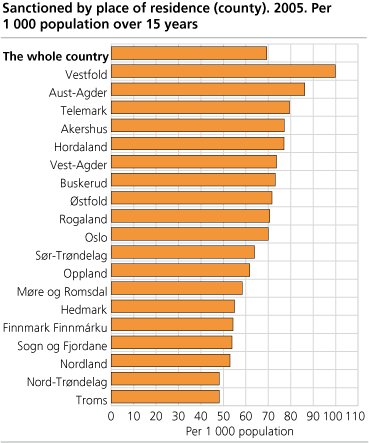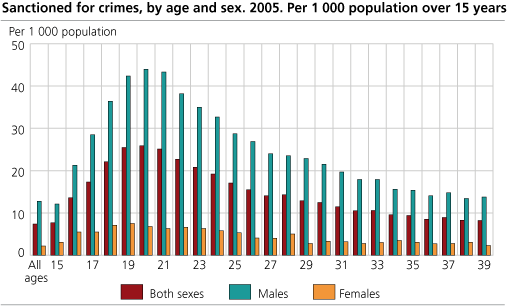Content
Published:
This is an archived release.
One of ten in Vestfold sanctioned
273 000 persons were given 316 000 sanctions in 2005. That means, 7,3 per cent of the population over the age of 15 were sanctioned in 2005, and one out of ten of those were sanctioned for one or more crimes.
The most serious offences, crimes, increased by 12,8 per cent, whilst misdemeanours increased by only 3,8 per cent from 2004 to 2005.
In the previous three-year period, there was an average increase of 21,2 per cent yearly in the total number of sanctions, while statistics for 2005 shows an increase of only 4,7 per cent. On the spot fines for misdemeanours against the Duty Act and traffic misdemeanours are background for the large increase previous years, but this type of sanction now increased by only three per cent. On the spot fines comes to two thirds of all sanctions, and three quarters of all sanctions against misdemeanours.
Largest share of sanctioned for crimes in Oslo
One out of ten persons from Vestfold were sanctioned for one or more offences in 2005, while to comparison only one out of twenty among residents in Nord-Trøndelag and Troms. Oslo has, however, most sanctioned for crimes - 9,7 per 1 000 population, in contrary to 7,1 per 1 000 population in the whole country. Of all residents in Norway who was sanctioned for crimes, a little beyond 16 per cent (4 300 of 26 400) were residents in Oslo. Vest- and Aust-Agder had an approximate same shares - both with 9,3 per cent per 1 000 population. Oppland had the smallest share of sanctioned, with less than half the size of shares in Oslo and in Aust- and Vest-Agder.
Young men over-represented
In 2005, 11 per cent of the male and 3 per cent of the female population over the age of 15 were sanctioned once or more. A great share of this applies to on the spot fines for misdemeanours against the Duty Act and traffic misdemeanours, and it is considerably less sanctioned for more serious offences: 1,3 per cent of the males and 0,2 per cent of the females which in 2005 were sanctioned for one or more crimes.
21 per cent of the sanctioned were women. We find the largest female shares among those sanctioned for offences of profit (23 per cent), traffic offences (22 per cent) and narcotic crime (18 per cent).
There are young men that are most frequently sanctioned for the most serious offences. More than four per cent of all men in the age 19-21 years were sanctioned for one or more crimes in 2005. More than half of all sanctioned for crimes were under the age of 30.
Some are sanctioned more than once
13 per cent of the sanctioned got more than one sanction in 2005, and the younger got more often several sanction during the year than the older. Women are to a smaller extent than men sanctioned several times - where respectively 7 and 15 per cent got more than one sanction. 6 500 persons were sanctioned three or more times during 2005.
| Sanctions in crime cases, by group of offence. 1997-2005 |
| 1997 | 1998 | 1999 | 2000 | 2001 | 2002 | 2003 | 2004 | 2005 | |||||||||||||||||||||||||||||||
|---|---|---|---|---|---|---|---|---|---|---|---|---|---|---|---|---|---|---|---|---|---|---|---|---|---|---|---|---|---|---|---|---|---|---|---|---|---|---|---|
| Total | 17 192 | 21 128 | 22 465 | 21 444 | 34 962 | 27 513 | 29 380 | 29 529 | 33 307 | ||||||||||||||||||||||||||||||
| Economic offences | 1 360 | 1 289 | 1 269 | 1 215 | 1 816 | 1 299 | 1 382 | 1 606 | 1 846 | ||||||||||||||||||||||||||||||
| Other offences of profit | 6 902 | 7 281 | 7 544 | 6 658 | 9 652 | 7 376 | 8 213 | 8 217 | 9 333 | ||||||||||||||||||||||||||||||
| Offences of violence | 2 989 | 3 414 | 3 435 | 3 195 | 5 055 | 4 186 | 4 687 | 4 826 | 5 777 | ||||||||||||||||||||||||||||||
| Sexual offences | 369 | 443 | 433 | 356 | 510 | 429 | 571 | 570 | 722 | ||||||||||||||||||||||||||||||
| Offences of narcotics | 4 374 | 7 004 | 8 212 | 8 374 | 14 861 | 11 894 | 12 265 | 11 815 | 12 524 | ||||||||||||||||||||||||||||||
| Damage to property | 534 | 757 | 625 | 715 | 1 170 | 873 | 867 | 905 | 1 049 | ||||||||||||||||||||||||||||||
| Environment offences | 12 | 5 | 16 | 13 | 14 | 5 | 7 | 12 | 17 | ||||||||||||||||||||||||||||||
| Other offences | 652 | 935 | 931 | 918 | 1 884 | 1 451 | 1 388 | 1 578 | 2 039 | ||||||||||||||||||||||||||||||
Largest increase for sexual crime and violence
There were given more sanctions for all groups of crimes in 2005, compared to the previous year. Largest percentage increase was for sexual- and violent crimes, with 27 and 20 per cent respectively. In terms of percentage, distribution between the groups of offences is fairly the same compared to the last five years: In crime cases it is still narcotics (38 per cent), crime for profit (28 per cent) and violence (17 per cent) which is the main reason for sanction.
Large increase in conditional sentences
There has never before been registered so many settled cases in court as in 2005, and all types of sanctions have increased from 2004 to 2005. The largest increase had conditional sentences, 40 per cent more than the previous year. The increase is divided between several different types of offences, but conditional sentences for driving under the influence of alcohol and narcotic crimes stands for almost half the increase. Unconditional prison sentences also had a large increase last year of 16 per cent. The average length of the imprisonment had a modest increase compared to 2004. Amongst the unconditional sentences given in 2005, 68 per cent was for up till three months, 20 per cent were between three months and up till one year, and 12 per cent of the sentences exceeded one year.
|
New and expanded statistics on sanctioned
Statistics Norway has for the annual 2005 further developed the statistical unit for sanctioned persons. The unit distinguishes from previous publications because persons without valid official Norwegian reference number now are being identified by name. This new method of identifying sanctioned persons, gives somewhat less sanctioned than will be the case with the previous method. The official statistics on sanctions are now slightly changed, and expanded with seven new tables on sanctioned. The new statistics give different surveys on sex, age place of residence, number of sanctions and the sanctioned' principal offence. Of quality reasons, previous table on citizenship is changed, and a table on conditional sanctions by type of sanction is removed. |
Contact
-
Sigmund Book Mohn
E-mail: sigmund.mohn@ssb.no
tel.: (+47) 94 32 77 22
-
Reid Jone Stene
E-mail: reid.jone.stene@ssb.no
tel.: (+47) 99 02 22 01



